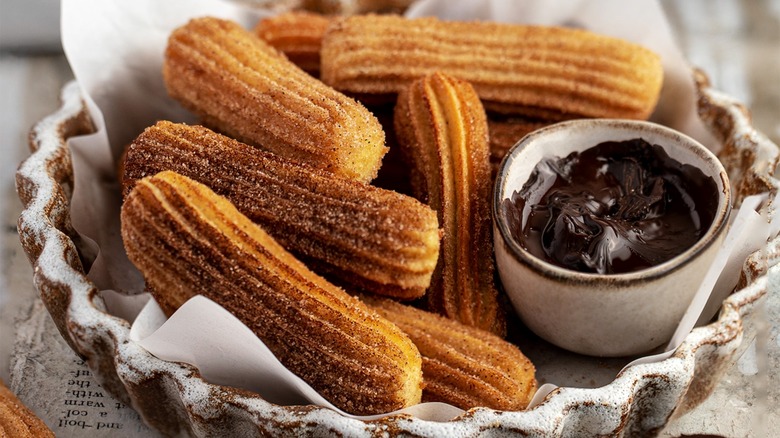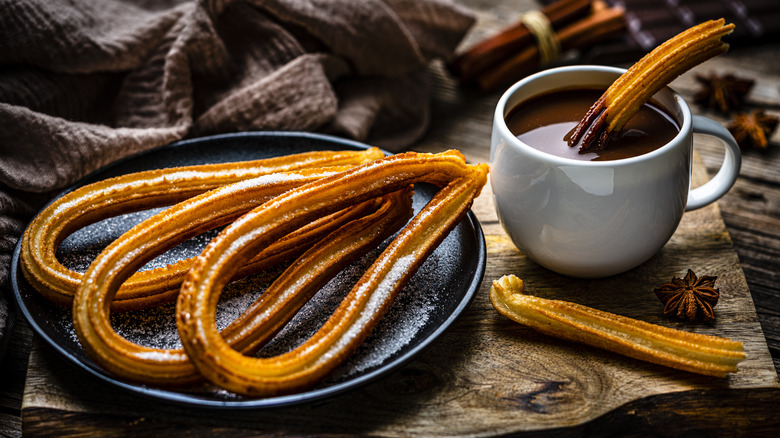The Murky Origins Of Churros, From China To The Spanish Mountains
It's hard to trace back the history of fried dough — it's a crunchy treat that's universally enjoyed, albeit in different forms and flavors. Greece calls the syrup-soaked loukoumades its own, stuffed doughnuts take the form of bombolone in Italy, South Africans enjoy the braided fried dough that is koeksister, and churros are largely believed to be a gift that the world can thank Spain for. But are churros truly Spanish? Turns out, they may not be!
Because fried dough exists in some form in pretty much all corners of the world, tracking a particular version's origin can often be a complex matter, and such is the case with the churro. The churro transcends all borders, thanks to the indisputable love for these handheld, cinnamon sugar-covered strips of fried dough. But if there's one thing that no one can agree on, it's who gave the world its first churro.
Some believe that churros originated in Spain, whereas others find that a similar dish has been eaten in China for much longer, crediting Chinese and Portuguese traders for their popularity. Some experts even cite recipes from the 8th and 9th centuries that suggest that the churro may very well have Arabic roots. Who would've thought the humble churro would have such a messy past?
Some theories say that Spain may have invented churros
Churros are widely believed to be of Spanish origin, and that may very well be true. According to popular legend, the shepherds of Spain were the ones who invented the churro. Looking for an alternative to fresh bread while tending to their sheep high up in the Spanish mountains, the shepherds turned toward a simple flour, water, and salt dough mixture, fried it in hot oil, and voila! The churro was born. These fried sticks were purportedly named after the Churra sheep that the shepherds tended to, and the sheep's ridged horns are believed to have inspired the churro's star-shaped appearance.
Legends and tales aside, there may be some truth to the theory that churros come from Spain, or the European continent at the very least. Food historian Michael Krondl tells BBC that the churro is a syringe fritter — a type of fried food that's passed through some type of gadget that gives it its shape — and such fritters have been around in Europe since the 16th century.
Recipes from the 12th century even indicate that a fried food akin to a churro existed during Moorish Spain, whereas mentions of a churro-like food in 8th and 9th-century Arab texts imply that the fried food could have Arabic roots as well. Other experts, however, believe that churro is nothing but a version of a popular Chinese snack that's evolved through the years.
The Chinese snack that could be the churro's ancestor
What adds to the churro's murky origin is that a suspiciously similar version exists in China, and it's named "youtiao"after the Cantonese word for oil-fried devil. Legend has it that the snack was invented between the 12th and 13th centuries when a Chinese baker joined two strings of dough and threw them in hot oil to symbolically protest against and inflict pain on Song Dynasty's Chancellor Qin Hui and his wife. The youtiao is eaten similarly to a churro, and the deep-fried dough is served with rice congee or soy milk for dipping.
Some theories claim that it was the Portuguese who entered China in the 1500s and introduced youtiao to the rest of the world as a churro. In fact, cookbook author Mandy Lee tells BBC that youtiao is exceedingly similar to the churro's cousin, porra: "It's strange because normally when foods get adopted by different cultures, they undergo more of a change but the porra is 95% a youtiao."
Food historian Michael Krondl, however, isn't so convinced and finds the theory that Spain got its churro from China "laughable." Recipes of fried dough exist in 1st-century Roman cookbooks, so even if churros aren't exactly Spanish, Krondl finds that they're certainly a variation of something that's existed in the Mediterranean region for much longer than China. Regardless, there's no definitive theory as to who invented the churro (Spanish shepherds or Chinese bakers?), and one can only be thankful that whoever did invent it made the world a sweeter place.



